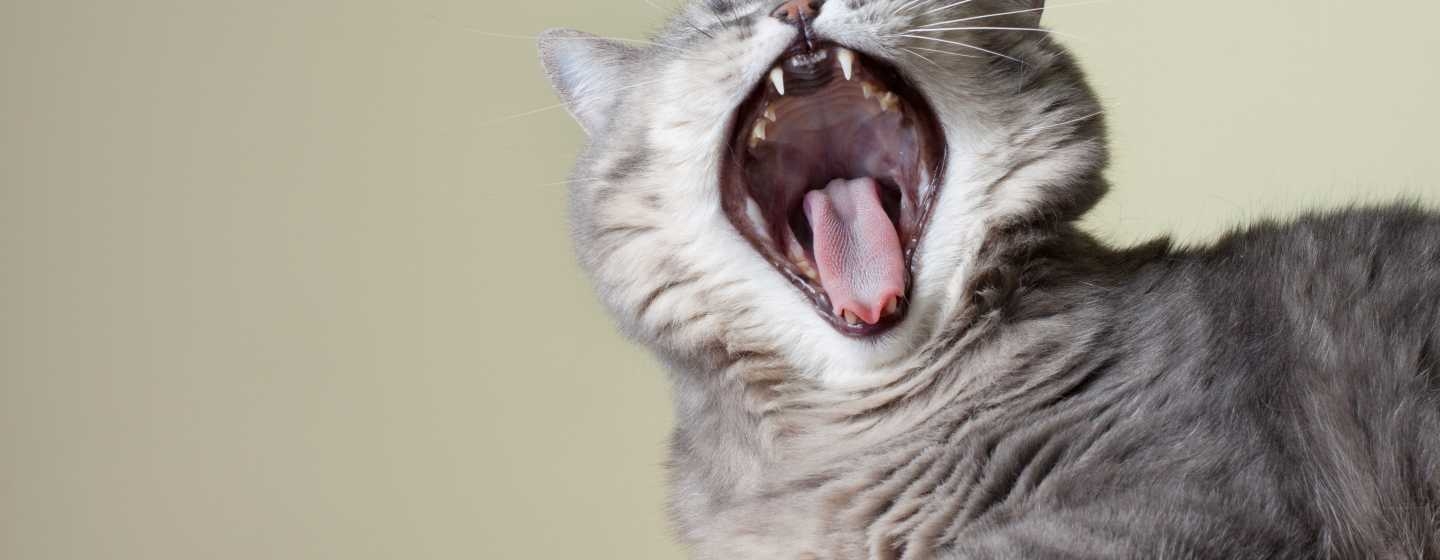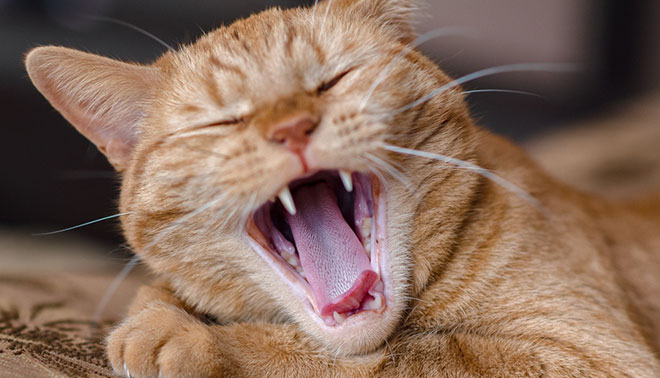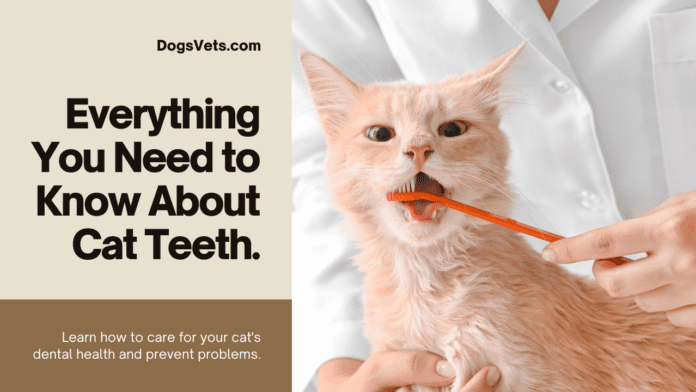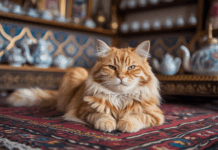Last Updated on January 31, 2024 by Dogs Vets
How Many Teeth Do Cats Possess, and What Do They Do? (& Everything Else You Need to Know About Feline Dentistry)
Ever gazed into your cat’s mesmerizing eyes, captivated by their playful grin? Have you ever wondered about the intricate world hidden within that adorable mouth? While humans boast 32 pearly whites, our feline companions have a slightly different story.
Buckle up, cat lovers, because we’re about to embark on a fascinating journey into the captivating world of cat teeth!
Unlike us, adult cats sport a total of 30 permanent teeth. That might seem like a close call, but those two missing chompers don’t diminish their impressive dental arsenal.
Just like humans, cats possess the familiar incisors for nibbling, canines for grabbing and puncturing, and molars for grinding. But here’s the twist: cats also have premolars, acting as the workhorses between canines and molars, responsible for tearing and shredding tougher bites.
But these teeth are more than just pretty (or not-so-pretty) fixtures. They play a vital role in every aspect of a cat’s life. From the thrill of the hunt to the meticulous self-grooming ritual, each tooth serves a specific purpose.
Their sharp incisors and canines are perfectly adapted for tearing flesh and puncturing prey, ensuring efficient meals.
Their cunning premolars and molars help them devour even the toughest morsels. These chompers are also essential for grooming, with incisors combing through fur and canines tackling hard-to-reach areas, keeping their coats pristine and parasite-free.
But beyond the practicalities, cat teeth are a window into their fascinating nature. Unlike humans, cats lack wisdom teeth, simply because their jaw size wouldn’t accommodate them.

And here’s a real jaw-dropper: their upper fourth premolar and lower first molar on each side are aptly named “carnassial teeth.” These specialized beauties have a scissor-like action, perfectly designed for shearing flesh and bone – think miniature guillotines!
However, it’s not all sunshine and sharp edges in the feline dental world. Just like humans, cats are susceptible to dental issues. Bad breath, difficulty eating, excessive drooling, and pawing at the mouth can all be signs of trouble. If you notice any of these red flags, don’t hesitate to seek veterinary attention.
Caring for your cat’s dental health is crucial for their overall well-being. Regular brushing with a cat-specific toothpaste and gentle brush can go a long way.
Dental treats and toys designed to scrape plaque and tartar can be a fun and effective addition. And most importantly, schedule yearly vet checkups to ensure any potential problems are caught early.
By understanding your cat’s dental anatomy, its role in their well-being, and proper care practices, you can ensure your furry friend maintains a healthy, happy smile for years to come.
Remember, a healthy mouth contributes to a healthy cat, and a healthy cat means more purrs and cuddles for you! So, the next time you admire your cat’s playful grin, remember the fascinating world of teeth that lies beneath, and give them a gentle head scratch for good dental hygiene!
More Than Meets the Eye: The Number Game
Adult cats, in all their whiskered glory, boast a total of 30 permanent teeth. That’s just two shy of our own 32, making them surprisingly well-equipped for their carnivorous pursuits. But before we delve into the specifics, let’s address a common misconception: “teeths.” The singular form of “teeth” is “tooth,” so remember, it’s 30 teeth, not 30 teeths.

A Breakdown of the Bite Squad: Incisors, Canines, Premolars, and Molars
Now, let’s break down this impressive arsenal tooth by tooth:
- Incisors (12): These tiny, sharp front teeth are the nibblers, perfect for gripping and tearing food. Think of them as miniature steak knives.
- Canines (4): These long, pointed teeth, also known as “fang” teeth, are the grabbers. They come in handy for puncturing prey and holding it securely. Just imagine them as miniature daggers.
- Premolars (10): These are the workhorses, located between the canines and molars. They have a combination of sharp edges and grinding surfaces, ideal for tearing and shredding tougher bites. Think of them as miniature serrated steak knives.
- Molars (4): These broad teeth reside at the back of the mouth and are the grinders. They’re responsible for pulverizing food into a swallowable mush. Think of them as miniature mortar and pestles.
Remember, kittens start with 26 deciduous teeth (baby teeth) that are gradually replaced by their permanent set between 3 and 7 months old.
A Feline Feast: How Those Pearly Whites Work Their Magic
Those 30 teeth aren’t just for show; they play a crucial role in a cat’s ability to thrive:
- Hunting and Predation: Cats are obligate carnivores, meaning their diet revolves solely around meat. Their sharp teeth are perfectly adapted for tearing flesh, puncturing prey, and efficiently consuming their meals.
- Grooming and Hygiene: Cats are meticulous groomers, and their teeth play a vital role in keeping their fur clean and free of parasites. They use their incisors to comb through their fur, while their canines help groom hard-to-reach areas.
- Defense and Play: As natural-born hunters, cats also use their teeth for defense and play. Their sharp canines can deter aggressors, while playful nips and bites are a common form of feline communication.
Beyond the Basics: Caring for Your Cat’s Chompers
Just like our own teeth, good oral hygiene is essential for feline health. Here’s how you can ensure your cat maintains a sparkling smile:
- Regular Teeth Brushing: This might sound like a daunting task, but with patience and positive reinforcement, you can train your cat to accept (and even enjoy!) teeth brushing. Start with a finger toothbrush and gradually progress to a cat-specific brush with gentle toothpaste.
- Dental Treats and Toys: Dental chews and toys designed to scrape plaque and tartar can be a fun and effective way to support your cat’s oral health. Just make sure they’re appropriate for your cat’s size and chewing habits.
- Schedule Regular Vet Checkups: Annual veterinary checkups are crucial for monitoring your cat’s overall health, including their teeth. Your vet can identify any potential dental issues early on and recommend appropriate treatment.
Warning Signs of Trouble: When to See the Vet
While cats are stoic creatures, they can’t tell us directly when their teeth are bothering them. Here are some signs to watch out for:
- Bad breath: Persistent bad breath can indicate dental problems like gingivitis or periodontal disease.
- Difficulty eating: If your cat seems reluctant to eat or exhibits pain while chewing, it could be a sign of dental disease or tooth damage.
- Drooling: Excessive drooling is unusual for cats and can indicate dental pain or infection.
- Pawing at the Mouth: If your cat frequently paws at its mouth, it could be experiencing discomfort due to dental issues. It’s vital to schedule a vet visit to get a proper diagnosis and treatment plan.

Beyond the Chompers: Other Feline Dental Quirks
The feline dental world holds a few fascinating surprises:
- No Wisdom Teeth: Unlike humans, cats don’t have wisdom teeth. Their jaw size simply wouldn’t accommodate them.
- Unique Carnassial Teeth: The upper fourth premolar and lower first molar on each side are called “carnassial teeth.” These specialized teeth have a scissor-like action, perfect for shearing flesh and bone. Think of them as miniature guillotines.
- Dental Floss…Not So Much: While flossing is crucial for human dental hygiene, it’s not typically recommended for cats. Their teeth are tightly packed, and flossing can damage their gums.
Frequently Asked Questions (FAQs) about Feline Teeth
My cat has fewer than 30 teeth. Is that normal?
It’s possible. Cats can lose teeth due to injury, dental disease, or other health issues. If you notice your cat has fewer teeth than expected, consult your veterinarian.
How often should I brush my cat’s teeth?
Ideally, daily brushing is best. However, even a few times a week can make a significant difference. Start slowly and gradually increase the frequency as your cat becomes more comfortable.
What type of toothpaste should I use for my cat?
Never use human toothpaste on your cat! It contains ingredients that are toxic to them. Use a specially formulated cat toothpaste, available from your vet or pet store.
My cat hates having its teeth brushed. What can I do?
Patience and positive reinforcement are key. Offer treats and praise during and after brushing sessions. Desensitize your cat by gently touching their mouth and teeth before introducing the brush. Consider consulting a veterinary behaviorist for professional guidance.
Are there any natural alternatives for maintaining my cat’s dental health?
Yes, some natural options can help. Chewing on catnip, dental treats made with natural ingredients, and raw meaty bones can aid in tartar removal. However, these shouldn’t replace regular brushing and veterinary checkups.
By understanding your cat’s dental anatomy, its role in their well-being, and proper care practices, you can ensure your feline friend maintains a healthy, happy smile for years to come. Remember, a healthy mouth contributes to a healthy cat, and a healthy cat means more purrs and cuddles for you!
Verified Source References:
- American Veterinary Medical Association: https://www.avma.org/resources-tools/avma-policies/veterinary-dentistry
- Cornell University College of Veterinary Medicine: https://partnersah.vet.cornell.edu/pet-owners/cat-teeth
- World Small Animal Veterinary Association: https://wsava.org/global-guidelines/global-nutrition-guidelines/
Disclaimer: This blog post is for informational purposes only and should not be interpreted as veterinary advice. Always consult with your veterinarian regarding your cat’s specific dental health needs.

















